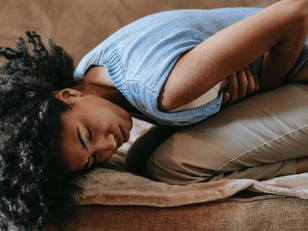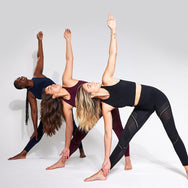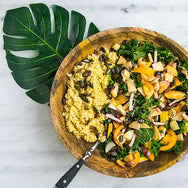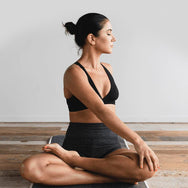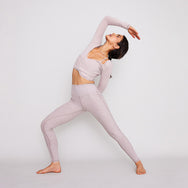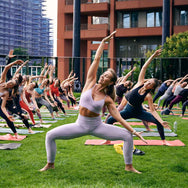Words by Angie Tiwari

“Of course I can’t touch my toes, I’m far too old for that!”
Does this sound like you? Or something a family member or friend that you’re encouraging to practice yoga might say? Lots of people tend to think yoga is for the young and flexible, but that’s not true. I’m going to tell you a story about how I successfully encouraged my parents to engage with this healing practice, the incredible benefits they experienced in their 60s and 70s, and why it’s really never too late to start yoga. To start off with...
WHAT ARE THE BENEFITS OF YOGA FOR SENIORS?
- Studies have shown that yoga helps to release serotonin (our happy hormone), lower cortisol levels and overall boost our mood
- Improves quality of sleep by increasing our melatonin levels
- Helps with stability, better balance and flexibility
- Regular movement can alleviate aches and pains that may come as we age
Let’s rewind to India in the 70's. My Mum would wake for her daily 5am yoga practice made up of asana (postures), meditation, kriyas (cleansing techniques) and pranayama (yogic breathing). It was a ritual that she loved, and she was extremely disciplined with it. At the end of the 80s she married my Dad and they moved to the UK which is where she “lost the energy to continue as other responsibilities took over.”
Though she didn’t have her regular morning ritual, she still passed on some of this yogic magic and eastern wisdom to my sister and I when we were growing up. We learnt agnisar kriya (a purification technique to cleanse the digestive organs, lower chakras and strengthen the abdominal muscles) and we have fond memories of her teaching us padmasana (lotus pose) and other asanas.
Both of my parents taught, through osmosis, the importance of having a strong and unwavering belief in the divine. We would fold our hands and say ‘Jai’ every time we turned the lights on in the house to show respect and to give thanks for electricity. My Dad echoed this through his morning rituals by the shrine, together we’d chant practising Bhakti yoga (yoga of devotion) and practice tapas (self-discipline).
Fast forward to my yoga teacher training and I really wanted to practice with my Mum, but whenever I suggested it, she really had no interest and seemed almost anti her being involved. In hindsight I realise that this was a fear of starting something she used to love and be so dedicated to.

When the lockdown came, I saw this as the perfect opportunity to encourage my Mum to get back into trying yoga, and to join my weekly online classes. She joined! I was so happy that she had the courage to start again, but most importantly that she enjoyed it. Her approach to yoga is hugely admirable, she takes it in her own time, she slows down when something doesn’t feel right, and she does what she feels comfortable doing so she can actually enjoy it. This is the approach I believe everyone (especially older adults and beginners) should have.
Over the last year and a half, this has once again become her “everyday ritual” which she has continued into her retirement. As someone who has experienced insomnia, she’s also noticed that her every day routine means that she sleeps so much better. Her practice consists of 20 minutes of asana (postures), bhramari (humming breath) and eye yoga (strengthens eye muscles). She truly believes “there is no age for yoga. It is a state of mind." She is 66 years old.
WHAT TYPE OF YOGA IS BEST FOR SENIORS?
It completely depends on what you’re after. If you’re wanting to improve your balance, flexibility, strengthen your bones and find that ritual for regular movement then you could work on:
- Incorporating some easy yoga poses. Try a vinyasa (more dynamic) or a yin (slower and more restorative) class
- Don’t worry too much about the duration of your practice
- Aim for consistency (10 mins a day is better than 1 hour once a week!)
- Use your breath to align with the movement to get even more benefits

If you’re looking for a way to be more present in your life, and feel re-energised then you could work on:
- Using pranayama (yogic breathing) to energise your body in turn allowing your mind to feel more alert (shorter sharper breaths will do this)
- Try longer, slower breaths to activate your parasympathetic nervous system, lower blood pressure and reduce stress and inflammation caused by increased cortisol (our stress hormone)
- Try to bring a meditation into your every day by being aware of your senses, this can be really grounding and helpful to keep you in the present moment
At the beginning of this year, my Dad developed a painful rash on his finger that started spreading across his hands making his fingers yellowish, parts of his hand were red raw and his nails were brittle. It was as if his hands had aged by 20 years in the space of a few days. After numerous and repeated tests, CT scans, antibiotics and X-rays by 4 different doctors and consultants, they concluded he was healthier than they were and they couldn’t understand the cause.
I’m no doctor but I really believed the stress and life change of retiring had caused an increase in his cortisol levels which in turn led to this inflammation across his hands. My Dad is extremely connected to the divine, yet has never sat down to meditate or focus on his breathing. After successfully convincing my Mum to rekindle her love of yoga, and watching her reap the benefits, I knew this was something that would also help my Dad.
I knew he needed the facts before he could get started, so I started by sharing a bunch of studies on how meditation positively affects our brains, the impact it has on our hormones, and why it’s something he should try. He read all of these, and started 10 minutes of meditation every morning. He not only believed in it, but he also loved the experience and found it incredibly calming. He said, “Once I began the meditation, the swelling slowly started to disappear and within 10 days the improvement was remarkably surprising. A living example in me strongly recommends that people take up Meditation and Yoga, which I have taken up in my 70s.”

Around the same time, he had high blood pressure and was asked to monitor it using a BP monitor. He was told that if it didn’t lower then they would need to prescribe him medication. He upped his meditation from once to 3 times a day, again just for 10 minutes at a time. After meditating his systolic and diastolic blood pressure had lowered, and after some time he could return the BP monitor to the doctors without having to take medication long term. The recordings were:
SBP readings:
Before meditation: 146 - 172
After meditation: 122 - 167
DBP readings:
Before meditation: 79 - 98
After meditation: 68 - 91
HOW TO START YOGA AS AN OLDER ADULT
- Do as much research as you need to so you have all the information before you get started, especially if meditation is not something you’ve really believed in before
- Remember that starting something new can feel a little intimidating and that’s okay! It can also be exciting and open your eyes up to things you’ve never considered before
- Try to be as open minded as possible
- Meditate by using a guide and try different types of meditation to find something that you like and that works for you
CONCLUSION
In summary, it’s never too late to connect with yourself through a yoga practice, to find tools you can use to support your physical and mental health, and most importantly to try something that may feel totally foreign to you. If you’re reading this and want to encourage a family member to use the practices of yoga to better their health, then share these stories! Figure out how best you can approach this subject with those who may feel reluctant to start yoga because they think they’re “too old”. Yoga is not for any particular age, it is for everyone, and I hope my story above shows you why it’s never too late to start yoga.
























